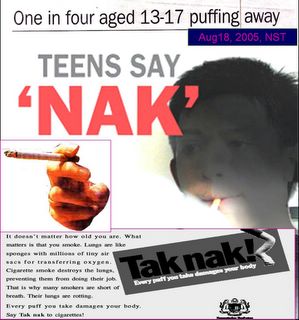- Nearly 25 per cent of Malaysian youth smoke, most of them between 13 and 17.
- A third of all smokers nationwide are young women.
- In rural areas, children as young as six smoke.
Public Health Specialist Association president Dr Zainal Ariffin Omar said:
"For many years, we have only been seeing older people, aged 50 and above, suffering lung cancer. Now we see patients as young as 18."
Smokers are vulnerable to cancers of the larynx, oesophagus, stomach, bladder, pancreas, cervix, colon and rectum. Smoking also causes heart disease, stroke, chronic obstructive pulmonary disease and hypertension. Long-term smoking can reduce fertility in women and cause sudden infant death syndrome.
Among women, Dr Zainal noted, smoking also contributed to breast and cervical cancers. Dr Zainal, who is also deputy director of the Health Ministry’s communicable diseases control division, said the ministry had been promoting a healthy lifestyle among youth, urging them, in particular, not to smoke.
Malaysian Council for Tobacco Control president Professor Dr Syed Mohamed Aljunid said children were picking up the habit because of adults’ influence — including parents, teachers and school counsellors. "Advertisements, nicotine addiction and peer pressure also contribute to the problem."
Dr Syed Mohamed is worried about the financial cost of treatment, with the prospect of rising numbers of youthful patients. He said the Government did not have a specific health policy for those between 12 and 18, unlike one for children up to five years of age and senior citizens.
Universiti Putra Malaysia Assoc Prof Dr Lekhraj Rampal said a recent study of 4,705 people, 2,080 males and 2,625 females aged 25 years and below, revealed that 46.2 per cent of the males and 3.3 per cent of the females smoked. Of them, 25.4 per cent were Malays, 13.6 per cent Chinese, 10.9 per cent Indians and 50.1 per cent others.
Dr Rampal said 26.6 per cent of the smokers were Sarawak Bumiputeras and 27.3 per cent Sabah Bumiputeras.
A UPM study of 18,000 people last year revealed that 87.1 per cent smoked. What was truly startling was the revelation of the age of smokers. Among 15-year-olds, 21 per cent smoked; 16 (32.2 per cent); 17 (35.6 per cent); 18 (45.5 per cent); 19 (51.4 per cent); and 20 (49.2 per cent).
So, what is the effectiveness of the "Tak Nak" campaign? The government had spent multi-millions on the Tak Nak and the results is: "we had made the youngsters far more aware of smoking and the uhm associated with it, except to inform them that it is "possibly" cancerous.
So, the campaign had successfully generated far more smokers particularly, amongst the youth. Is that a success? Or, maybe, the government must triple the budget expenditure for someone to make it better? Is this also part of the NEP or MA, or should it be included there?

1 comment:
i think your template a bit koyak leh
Post a Comment